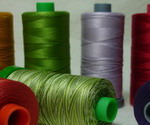Last weekend I had the pleasure of attending a class with Katrina Hadjimichael. http://katrinahadjimichael.blogspot.com.au/
The class was hosted by Corliss of Threadbear Patchwork and Quilting in Castlemaine. http://www.threadbear.com.au/
I have been an admirer of Katrina’s work for a number of years, so when I heard that she was to teach here in Victoria, I knew I had to be there! The quilt being taught was “Longbourne”, number 3 in Katrina’s Jane Austen series, which currently numbers eight. It’s a feast of applique, fussy cutting and English Paper Piecing. Bliss!

Katrina and “Longbourne”.
Twenty eager ladies gathered in the light and cosy venue for a day filled with lots of learning, inspiration, friendship, laughter and delicious food (that I didn’t have to prepare!!)
When we arrived and found a spot to park our bags, belongings and bodies, we received a lovely little gift bag from Corliss, complete with chocolate sustenance and fabric treasures.

What’s inside?

Treasures!
Katrina also came armed with a gift: a copy of the recent Quilters Companion magazine which included a DVD featuring Katrina and her tips for Jelly Roll quilts.

Then to the real work of the day! Katrina is a very organised and meticulous teacher and led us through the various techniques and processes required to make our own version of Longbourne. All the extensive notes, beautifully drawn pattern sheets, and a collection of photos showing in detail various elements of the quilt, were presented in a display folder for each participant.

Pattern sheets and detailed instructions in a display folder.
Most participants chose to use reproduction fabrics for their quilts as in Katrina’s original, but one other brave soul and yours truly ventured into the realm of brights. I have decided this presents an additional challenge: many of the fabrics in bright modern fabric ranges have larger scale designs on them. For some elements of the quilt, especially the centre panel, small scale designs are also necessary. I found I had to go shopping for some additional fabric. (Oh dear, such a hardship)
At the beginning of the class one lady asked Katrina what her secret is for such accurate and neat work? In short, the answer is attention to detail. All applique components are tacked onto paper first. Katrina takes great care when tracing and cutting out her pattern pieces. No sloppy workmanship here!

Tacking onto cartridge paper for fussy cut components.

More tacking.
Here’s Katrina demonstrating how she makes tiny (3/8″) hexagons. And the thread of choice… Aurifil of course!! (Here she is using 50 weight).

And so, to sew. The bias stems come first.

Ready to applique the bias stems.
I have not done a great deal of actual sewing as yet, but I have done a little playing with various fabric combinations, and lots of thinking about my creation.

Playing and thinking.
And when Longbourne is finished, there may be another of Katina’s Jane Austen quilts calling me.

Lambton, the latest in Katrina’s Jane Austen collection.
Thank you Katrina and Corliss for a most enjoyable and inspirational day.
Filed under: Applique, Aurifil, Cotton Mako' Ne 50, English Paper Piecing, Hexagons, Home page, Patchwork, Reproduction Quilts | Tagged: applique, Aurifil, bias stems, English paper piecing, Fussy cutting, Hexagon, Jane Austen inspired quilts, Patchwork, Reporoduction fabrics | Leave a comment »









































 Naturally I used Ne 50, Ne 40, Ne 28 and Ne 12 in the art journal construction!
Naturally I used Ne 50, Ne 40, Ne 28 and Ne 12 in the art journal construction!












































